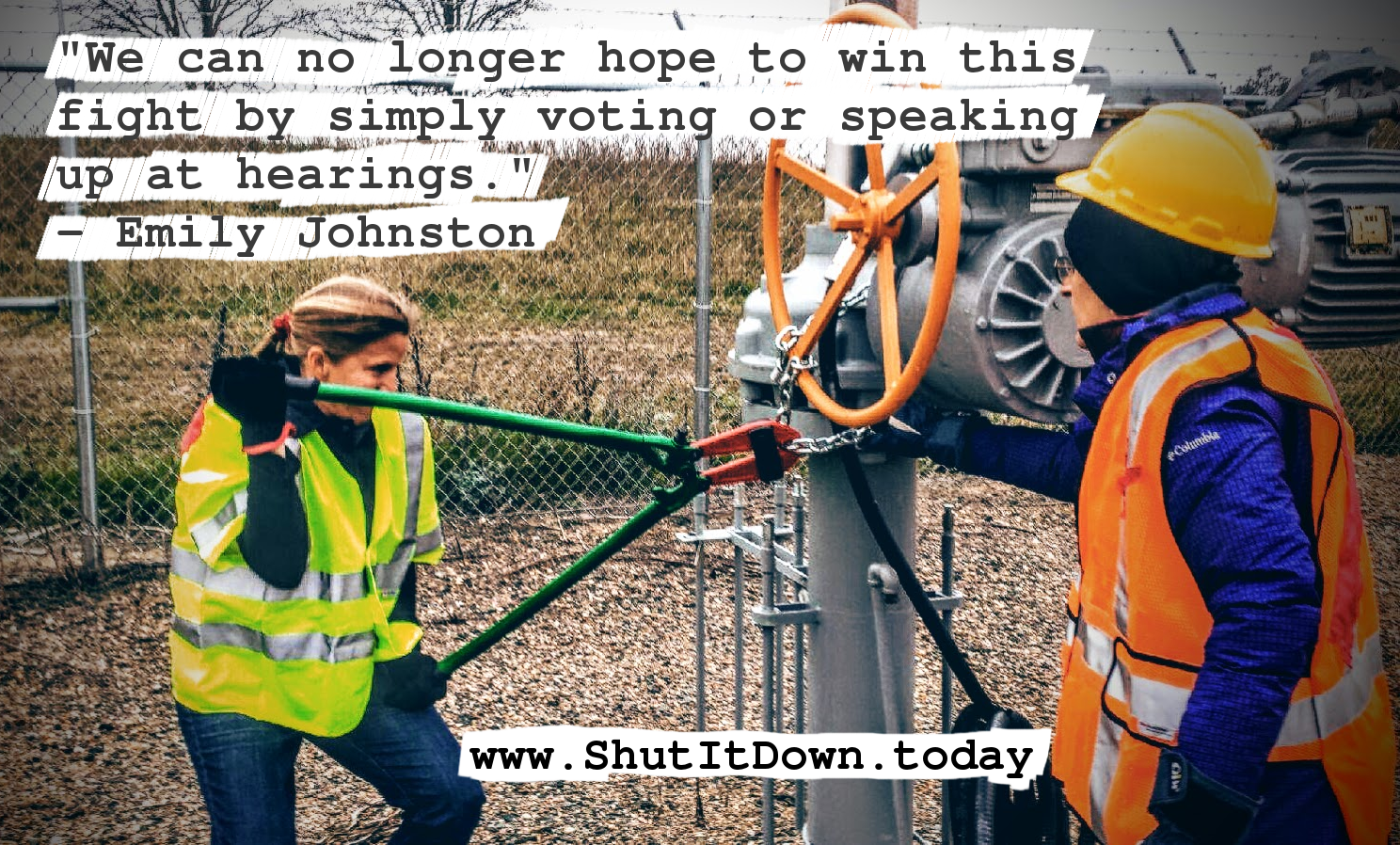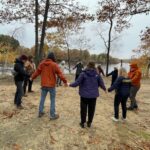These are my first thoughts, and I hope you will share your ideas. For links to post-election thoughts from my fellow Climate Disobedience Center Founders and updates on the conversation, click here.
Before jumping into post-election analysis a short reality-grounding. I want to start with a bit of context of where we are with the climate – the life support system for all of humanity which in it’s unraveling is bringing and will bring devastation and death in epic proportions to the most vulnerable populations around the globe first. Consider this week’s news that we’ve broken the North Pole: it’s running 36°F hotter than normal right now. It is clear we need dramatic action NOW – not four years from now. But how do we get there?
My hubristic immediate impulse is to jump into what the “climate movement” should do. But in reality I have no way of assessing that. All that I can do is speak from my own limited experience, from my own limited corner of this movement, and hope that it will speak to others in their condition. I trust that the ecosystem of the movement will cover all the other parts that are necessary, and the most important question for any of us is: What is MY role in this? Where am I put to the highest use? What is the thing that I have been given to do, given that the conditions that make stable human civilization on earth possible are collapsing?
Lessons from the 2000’s
The first things that started to pop into my head last week were thoughts of dread, “oh no… here we go again”. But they weren’t thoughts of dread about having another Bush administration destroying, torturing and invading the world, but dread that we – the generally comfortable white liberal class – might have the same reaction we did during those years. I was frantic in the years following September 11, in the run-up to the Iraq war, and the aftermath; going to countless vigils, rallies, marches, protests and playing some role in a few “actions”. I signed more petitions and wrote more letters to congress and to newspaper editors than I can count. And I know many many many of us did. The New York Times after a massive global protest proclaimed us “The Other Superpower”. And it was insufficient to prevent the suffering of millions. I can remember the quotes in the paper in which President Bush congratulated the hundreds and thousands of us for participating in the democratic process and exercising our first amendment rights, and went on with the invasion.
Commitment vs. Breadth
Online activism came of age during the Bush years. The internet was basically brand new, and MoveOn.org and others ushered in the era of online petitions and easy engagement with elected officials. Millions participated. In my two years working in DC from ’05-’07 for a small NGO, the name of the game was trying to make it easy as possible for people to engage. But the evidence is that it is not breadth of support that moves the dial on change, but rather depth of commitment. The theory was that as people took easy actions, they could then be moved up the “ladder of engagement” taking bigger and bigger actions until they were lobbying their representatives or whatever the appropriate top-level act was.
This, however, is the wrong approach in a time of climatic cataclysm. The cognitive dissonance between saying the world is ending and “sign this petition!” is crippling to building the type of movement capable of achieving the changes necessary. That’s what led us to begin to work together here as the Climate Disobedience Center. It is also the wrong approach in a time of fascism.
Three Threads
How do we think about the mechanism by which necessary change could come about, even as it failed to materialize during the Obama administration?
- One, that it is already too late to make meaningful strides towards mitigation and that we should, in the interim before a new administration/congress comes into office, focus on adaptation, local and state strategies.
- Two is to imagine that the left will band together, overthrow the president or force him to resign, and that a new day could dawn after the popular Tea Party of the Left sufficiently shifts the underlying politics.
- Third would be to hope that a sufficiently strong movement could be built around climate (given it’s existential relevance to all of humanity) in a way that option two cannot, and that such a movement could cross traditional alliances of ideology, making it possible (if not likely) that significant progress could be made over the next four years.
I’m sure there are other strategic frameworks in which to see the movement building options here. And by separating these threads out, I do not mean to imply that they are separate. Obviously acting in solidarity to those who are endangered – whether that is joining the government’s list if there is a registry of Muslims as there was after 9/11, Standing with Standing Rock, Black Lives Matter, creating sanctuary cities etc. should be the habit of all people of conscience. But if we focus only on number one, we will loose the war.
It actually seems to me that thread three has positive cascading effects for two, and two has positive cascading effects for one. As Van Jones named in his day-after livestream thoughts on Facebook: climate needs to be one of the big 3 fights we have. I’m convinced that having an explicit (and huge) fight on climate is still more than relevant post-election, and that serious climate-focused civil disobedience like we saw in the Tar Sands Valve Turning #ShutItDown action in October are needed more than ever.
Nonviolence researcher Erica Chenoweth has concluded that it only takes 3.5% of a population actively involved in non-violent resistance to force a confrontation for effective change, or to get a dictator to abdicate. It seems to me that creating climate direct action when the political establishment is opposed to such progress adds (rather than subtracts) to that overall effort. (Thus option three at the top cascades into number two)
Climate Disobedience as the keystone species in the ecology of the movement.
So how do we get there? How do we build that deeper commitment? When we formed the Climate Disobedience Center, we were holding at the center of our mission the examples of Tim DeChristopher’s history making oil and gas lease action and trial, and the more recent Lobster Boat Blockade. We saw the capacity of these type of, what I would call acts of prophetic imagination – actions that disclose the essential but hidden reality so powerfully that it provokes the reaction of the status-quo and builds moral clarity and energy on the side of truth.
The climate movement has failed to establish in the public mind a reality-based assessment of where we are, and what must be done to avert cataclysm. So our work, under whatever administration, should continue to pursue that goal. I am more convinced now that ever that principled acts of climate disobedience are the key to unlocking that door: individuals who are so convicted by the reality of the climate circumstances that they must publicly suffer for their acts of truth-living.
As state repression increases, as we are seeing at Standing Rock, it builds the moral and spiritual power of the movement if there is sufficient internal coherency and a public openness to suffer.
I have seen these actions play a key role in a movement ecology that moves towards greater commitment, passion and energy, AND have the benefit of focusing the narrative on the reality of climate change that is by in large ignored in the mainstream. As long as we (who participate in such actions) can avoid the trap of hero-worship that the comfortable use to cover over their unwillingness to take risk, these type of actions seem to work. What would it look like to be having some such action happening once a week across the country? I’m convinced if we did, we would then see even more of the lower risk, higher participation communities of resistance that have sprung up around the country, exemplified by the fine work that Marla has done in West Roxbury around Spectra’s fracked gas infrastructure expansion.
Building the Culture of Resistance
My role in this ‘movement’ seems to be to build that moral authority, sense of agency, and willingness to take risk further out into our movement by specifically organizing around it. I see continuing to work on two threads: supporting the high profile climate actions like #ShutItDown and support to face the trial and incarceration process with a fearlessness that inspires more, and working in the faith and Quaker communities to lay the spiritual foundation of that fearlessness that may generate new acts of solidarity and climate action.







Leave a Reply